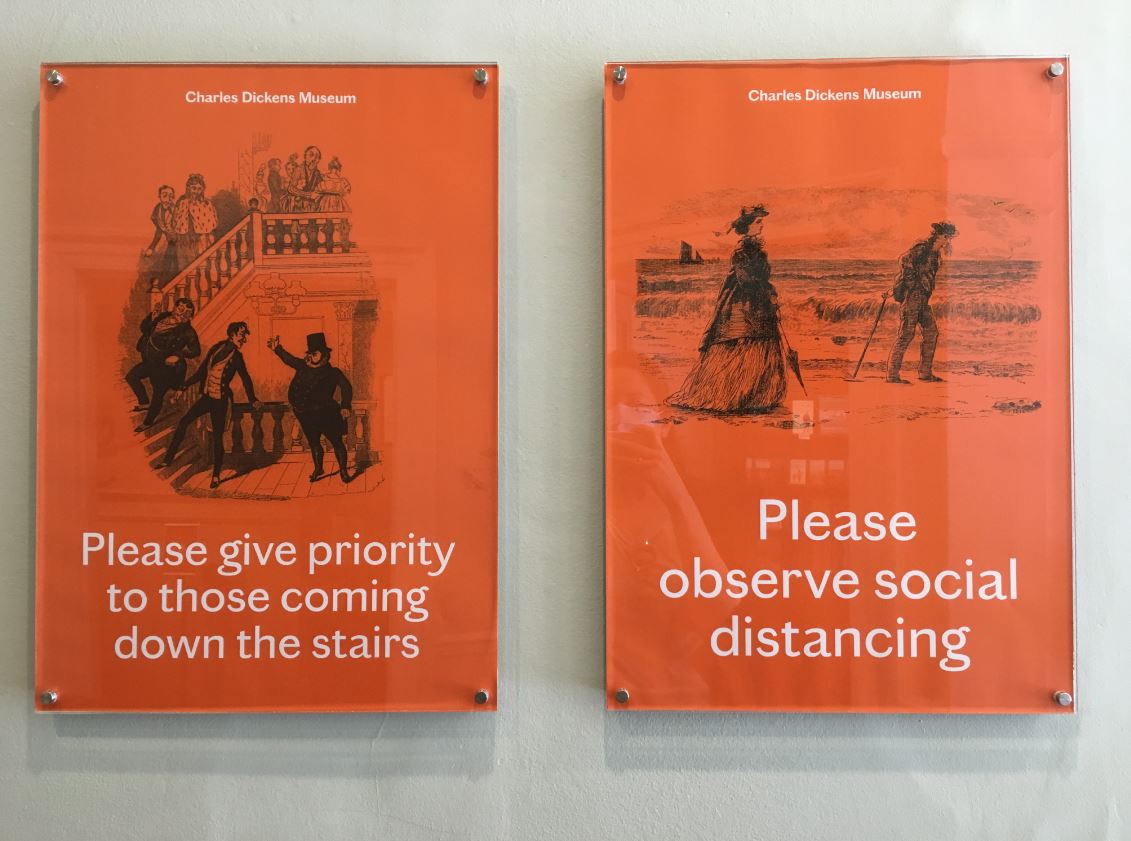The Covid Diaries 13: The Charles Dickens Museum
A review of London’s Charles Dickens Museum. In which I should probably have got the audioguide, but I didn’t because they’re not my favourite…
Welcome to the Charles Dickens Museum
The Charles Dickens Museum is just a stone’s throw away from the Foundling Museum. In fact, Dickens was a supporter and fundraiser for the Foundling Hospital. It was the residence of the Dickens family from 1837, when he was still relatively obscure, until 1840, when he had become much more famous after the publication of The Pickwick Papers, Oliver Twist and Nicholas Nickleby. The Museum occupies both 48 Doughty Street which was the family home, and next door 49 Doughty Street; this allows space for offices, exhibitions, a shop and a cafe. This layout of side by side town houses reminded me a little of Het Bijbels Museum in Amsterdam.
This was another of London’s small museums which I had not visited before. Overall I found it to be quite sweet, a little dated, probably good for family outings, and trying to be engaging with temporary exhibitions which bring it more up to date. They have done fairly well with one-way systems, social distancing and all the rest of it. In some spots though the spaces are too small to make this wholly effective.
A Quaint Museum Dedicated to one of Britain’s Most Famous Authors
In terms of the presentation of the museum itself, this is the aspect which I think is the most dated. On the other hand it’s in a way which makes it quite sweet (and I’m sure more evocative for children than a load of abstract displays and text panels). The rooms of the house are set up as they were used when the Dickens family lived there; kitchen, dining room, study, drawing room, bedrooms etc., with a mixture of original objects and replicas. I’m sure you’ve been to similar museums/historic homes, where the kitchen is full of dried herbs, plastic food etc. It sets the scene, but is not groundbreaking in a museological sense, particularly when most things are not original. Original items, whether originally in this house or from other periods in Dickens’ life, are generally indicated by little booklets which are stationed around the rooms.
Overall, apart from these booklets and one motion-triggered audio thing, there is not a lot of information for those who haven’t chosen to use an audio guide. I generally dislike audioguides because I like to go at my own pace. I therefore opted out and suffered a little for it. On the other hand though, when relying only on printed information, it’s interesting to see what it reveals or doesn’t.
Saint Charles Dickens?
One thing it does reveal is the immense presence in the public consciousness of Charles Dickens and his works. Some of the works that have been donated over the years include ‘Charles Dickens’ wardrobe’; window frames he may have looked out of or may have imagined characters being pushed through (what…?); even some iron bars from Marshalsea Debtor’s Prison, installed somewhat incongruously in what was his children’s nursery. The latter is a nod to Dickens’ own impoverished and difficult childhood.
That people took the time to preserve the objects and their associations and later donated them to the Museum to guarantee them a place in history, indicates to me that Dickens took on almost the qualities of a saint. Anything he touched, owned or even looked at seems to have taken on an afterlife as a relic. For the most part the museum does a good job of incorporating these into the visitor’s journey through the house.
In terms of what isn’t revealed, it’s maybe more of a case of evolving attitudes towards historic ‘great men’. By this I am alluding to the difficult and complex story of Charles Dickens and his wife, in which some believe he did not behave very well at all. In (seemingly) older written materials in the house it’s not well-surfaced, whereas newer materials seem to address it more directly.
Check out Technicolour Dickens for Yourself!
Ok, now I have a confession. The Charles Dickens Museum did have a temporary exhibition on when I was there. Shamefully I didn’t give it due attention so can’t really give you a review of it. Technicolour Dickens looks at the author’s canny use of his image as a public figure in promoting his work and his profile, and is divided into subjects like different artistic interpretations and uses of technology. It’s on for a while, so maybe I should go back some time and give it more of a chance.
So in summary, I would recommend the Charles Dickens Museum only if you think it’s your sort of thing. If you like historic houses with recreations of busy kitchens, overladen dining tables and short little beds, then great! Or if you really love Charles Dickens of course, and are not just a seasonal fan as I am (A Christmas Carol being one of my favourite things about the festive season). If you want new insights, there are a lot of scholarly works out there which I’m sure fit the bill. But if you want to support London’s small museums during a difficult year, particularly if you want to do so with kids in tow, then it could be worth popping by.
On its own merits: 3/5
Implementing Covid rules: 3/5
Technicolour Dickens until 25 April 2021
If you see this after your page is loaded completely, leafletJS files are missing.













